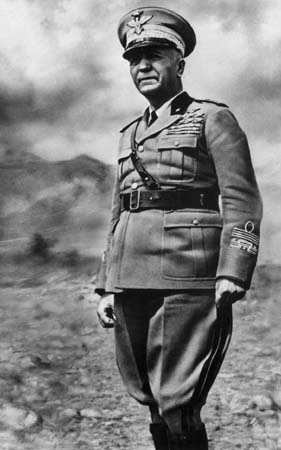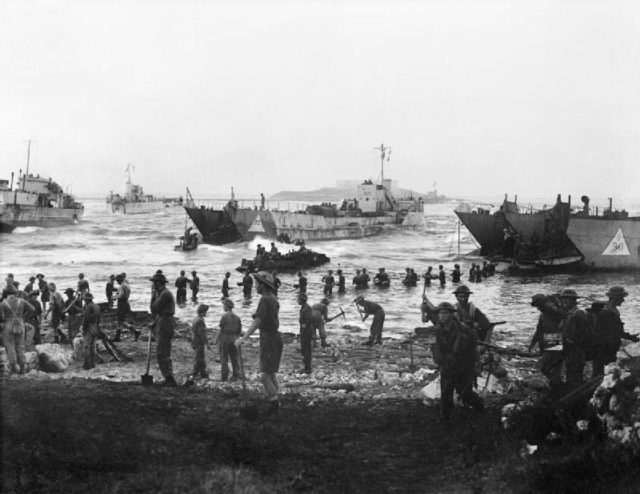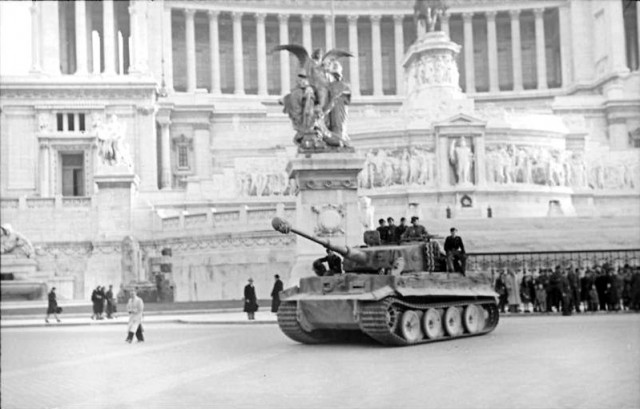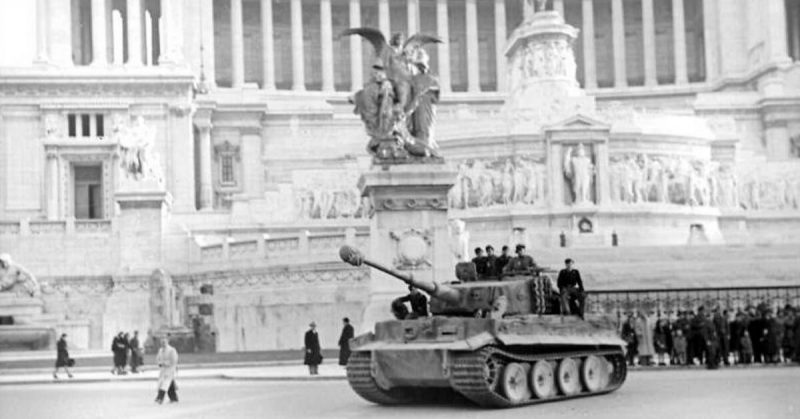General Tylor’s diplomatic and language skills resulted in his secret mission to Rome to coordinate an 82nd Airborne para drop with Italian forces. General Dwight D. Eisenhower would later say that “the risks he ran were greater than I asked any other agent or emissary to take during the war.”
To tell the story of General Taylor’s secret mission to Rome we need to go back a bit and look at the situation in Italy from July – September 1943.
On 25 July, the Grand Council of Fascism voted to limit the power of Italian dictator Benito Mussolini and handed control of the Italian armed forces over to King Victor Emmanuel III. The next day Mussolini met with the King, was dismissed as prime minister, and was then imprisoned. A new Italian government, led by General Pietro Badoglio and Victor Emmanuel III, took over in Italy.
Although they publicly declared that they would keep fighting alongside the Germans, the new Italian government began secret negotiations with the Allies to come over to the Allied side. On 3 September, a secret armistice was signed with the Allies at Fairfield Camp in Sicily.
On 3 September, British troops crossed the short distance from Sicily to the ‘toe’ of Italy in Operation Baytown. Two more Allied landings took place on 9 September at Salerno (Operation Avalanche) and at Taranto. The Italian surrender meant that the Allied landings at Taranto took place unopposed, with the troops simply disembarking from warships at the docks rather than assaulting the coastline.
One of the conditions agreed upon in the armistice was that the Allies would support the Italians in saving Rome from the Germans. For this plans were made for an operation called Giant II. This involved the 82nd Airborne which was to be landed over several nights in increments on five airfields near Rome.
They could not land closer to Rome due to the presence of several anti-aircraft batteries that had to be avoided by the troop carrier aircraft.On the ground, they would be supported and transported to Rome by Italian forces and would then aid the Italian in saving Rome from the Germans.
For this mission to succeed the Italians had to provide hundreds of trucks to move the 82nd Airborne to Rome, protect the airfields and suppress all anti-aircraft batteries that would threaten the slow moving transport aircraft. In the negotiations, the Italians accepted all these requirements without much hesitation which made General Ridgway, then commanding the 82nd Airborne, and General Taylor, commanding its artillery, very nervous.
They went to their superiors and proposed to send two representatives, one for the 82nd and one for the Troop Carriers, to Rome to determine the feasibility of the operation. General Taylor and Air Force Colonel Gardiner were selected to go to Rome and look things over.
The Secret Mission to Rome

For fear of being captured before Allies landed at Salerno, they were not to leave for Rome until shortly before September 9th, D-Day. They departed at 2 AM on September 7th, in full uniform, and boarded a British patrol boat which met up with an Italian corvette off an island. They moved to the Corvette with their baggage, which included a radio to strengthen the link between the Allies and the Italian high command.
After arriving on the Italian mainland at Gaeta, they were pushed ashore under the guise of prisoners picked up at sea to throw off any suspicious onlookers. Driven into the outskirts of Gaeta in a Navy car they transferred into a military ambulance and they headed to Rome, 75 miles away.
When they arrived in Rome, they were quartered and told that they would not meet the Chief of Staff Castellano until the following day, a delay that the Americans found hard to understand giving the fact that time only worked in favor of the Germans. Urging the Italians into action they were joined during dinner that night by an Italian general who informed them of the fact that the Germans were moving in more and more troops.

They were stopping supplies going to Italian divisions, on which the Americans were to rely for help, and the General could not even guarantee the security of the airfields on which the Americans were to land. He thought the plan could accomplish nothing but provoke harsher reprisals of the Germans.
Dismayed, Taylor and Gardiner asked to see the Italian Prime Minister Badoglio immediately, and they reached his villa in the middle of the night. Badoglio shared his Generals views and had urged the Allies to land North of Rome and only land paratroopers when they could be reinforced from nearby Allied forces. More fearful of the Germans than the Allies, Badoglio was more concerned with saving Rome from German reprisals than participating in an operation that could speed up the Allied liberation of but could endanger the existence of Rome. Badoglio, fearing the Germans, was also unwilling to announce the agreed upon armistice between Italy and the Allies.
At 01:21 AM Taylor wrote a message to the Eisenhower advising that Giant II was now impossible, and they took leave of Badoglio. They returned to their quarters and were informed at 08:00 AM that their message was sent and acknowledged.
September 8th was spent waiting and sending off messages to Eisenhower to clarify their message from 01:21 AM. At 03:00 PM they were ordered to return by Eisenhower back to him in North Africa as soon as possible. They got back in the Ambulance and were driven to an airfield not far from Rome and returned to North Africa without incident. Taylor thought this to be the most nerve wrecking part of the journey, fearing being shot down at any moment.
As it turned out, the calling off of Operation Giant II was a very close call; a General was sent to the departure airfields with the message to abort the mission. Some planes were already airborne and had to be chased to pass on the message.
Aftermath

Because of the time, it took for the new Italian government to negotiate the armistice with the Allies, the Germans had time to reinforce their presence in Italy and prepare for their defection. In the first weeks of August, they increased the number of divisions in Italy from two to seven and took control of vital infrastructure.
Once the signing of the armistice was announced late on 8 September, German troops quickly disarmed the Italian forces and took over critical defensive positions in Operation Achse. This included Italian-occupied south-eastern France and the Italian-controlled areas in the Balkans. Only in Sardinia, Corsica, and in part of Apulia and Calabria were Italian troops able to hold their positions until the arrival of Allied forces. In the area of Rome, only one infantry division—the Granatieri di Sardegna—and some small armored units fought with commitment, but by 11 September they were overwhelmed by superior German forces.
King Victor Emmanuel III and his family, with Marshal Badoglio, General Mario Roatta, and others, abandoned Rome on 9 September. General Caroni, who was tasked with defending Rome, was given duplicitous orders to have his troops abandon Rome (something he did not want to do), and essentially to provide rear guard protection to the King and his entourage so they could flee to the Abruzzi hills, and later out to sea.
